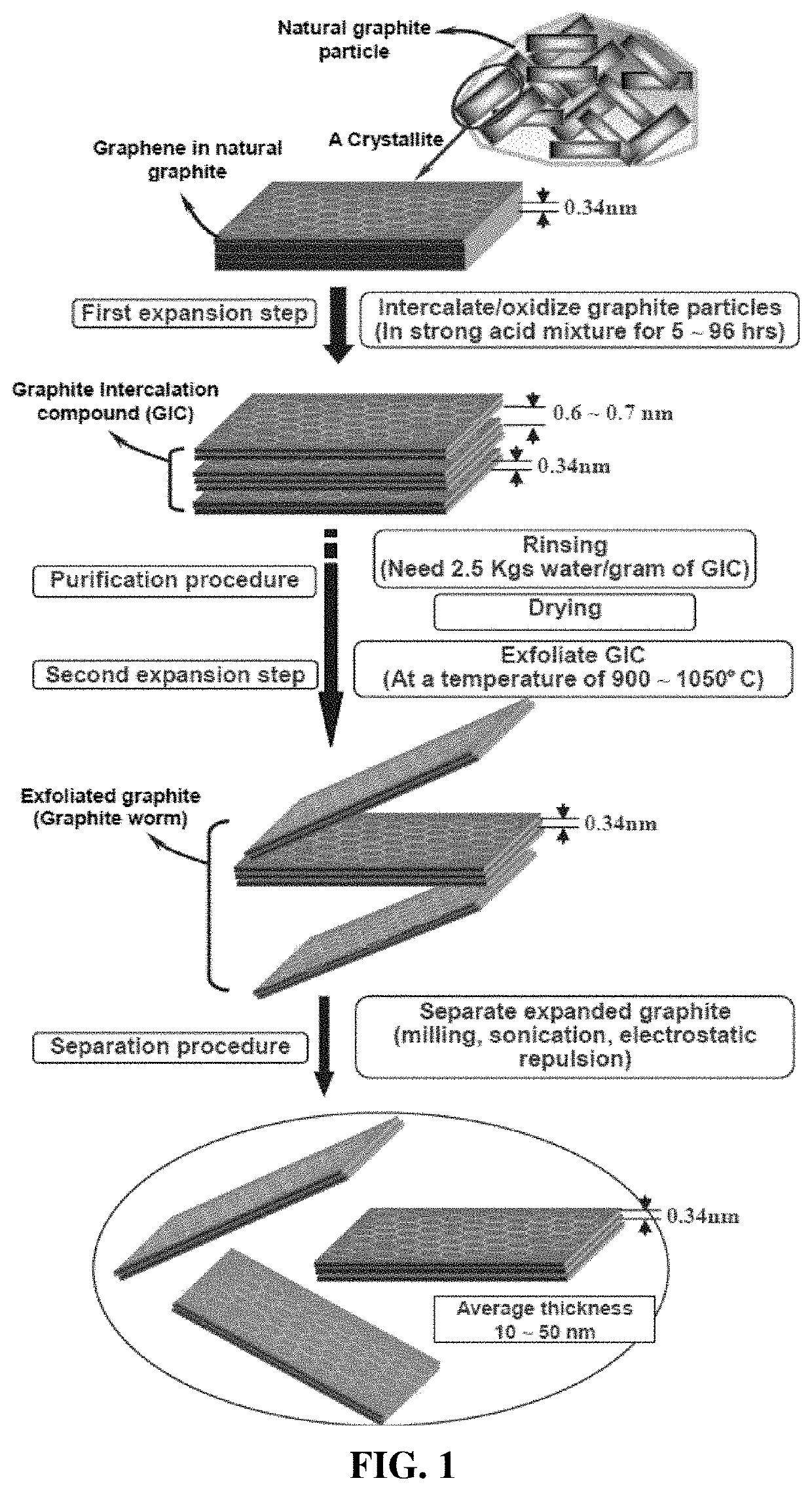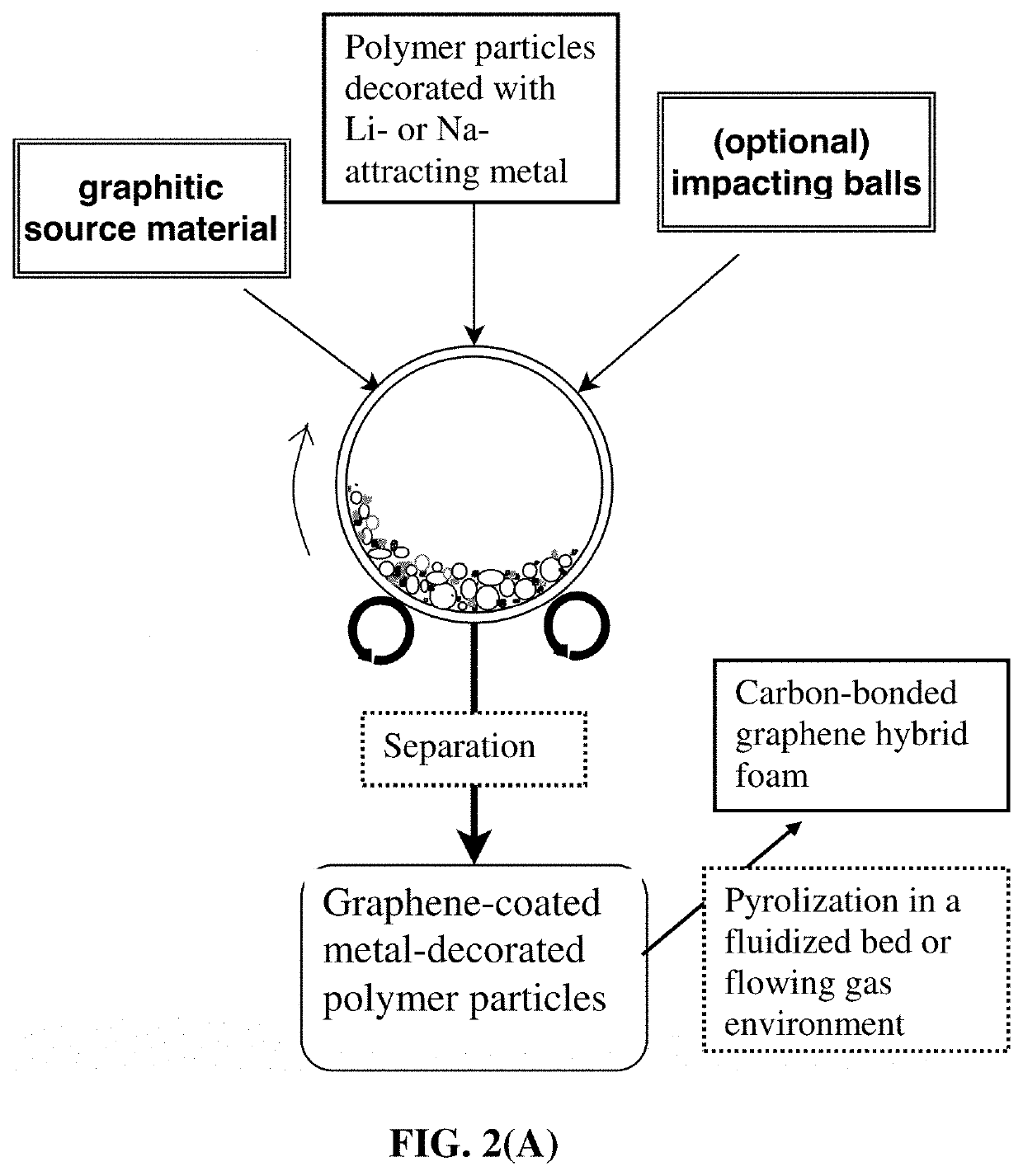Process for producing particulates of graphene/carbon-encapsulated alkali metal, electrodes, and alkali metal battery
a technology of carbon-encapsulated alkali metal and process, applied in the field of alkali metal batteries, can solve the problems of shortening and explosion of internal circuits, affecting the life of secondary batteries, and affecting the production of these types of secondary batteries, and achieves long and stable charge-discharge cycle life.
- Summary
- Abstract
- Description
- Claims
- Application Information
AI Technical Summary
Benefits of technology
Problems solved by technology
Method used
Image
Examples
example 1
Production of Graphene-Carbon Hybrid Particulates from Flake Graphite via Polypropylene Powder-Based Solid Polymer Carrier Particles
[0128]In an experiment, 1 kg of metal-decorated polypropylene (PP) pellets, 50 grams of flake graphite, 50 mesh (average particle size 0.18 mm; Asbury Carbons, Asbury NJ) and 250 grams of magnetic steel balls were placed in a high-energy ball mill container. For incorporation of higher melting point metals (e.g. Au, Ag, Ni, Co, Mn, Fe, and Ti) as a lithium- or sodium-attracting metal in porous graphene-carbon particulates, a small but controlled amount of the desired metal was deposited on the surfaces of carrier polymer particles using sputtering or chemical solution deposition of a precursor material (e.g. HAuCl4, which upon heating at a desired temperature, becomes Au metal). These metal-decorated polymer particles were then utilized as the impacting media (with or without using any externally added milling media, such as zirconia beads).
[0129]The ba...
example 2
Graphene-Carbon Hybrid Particulates Using Expanded Graphite (>100 nm in Thickness) as the Graphene Source and Acrylonitrile-Butadiene-Styrene Copolymer (ABS) as the Polymer Solid Carrier Particles
[0136]The ABS particles were decorated with a small amount of lithium- or sodium-attracting metal (0.1% to 30% by weight of Mg, Zn, Na, and Sn) using electroplating or sputtering. Then, in an experiment, 100 grams of metal-decorated ABS pellets, as solid carrier material particles, were placed in a plastic container along with 5 grams of expanded graphite. This container was part of an attritor mill, which was operated for 30 minutes-2 hours. After processing, metal-decorated particles of the carrier material were found to be coated with a thin layer of carbon. A small sample of carrier material was placed in acetone and subjected to ultrasound energy to speed dissolution of the ABS. The solution was filtered using an appropriate filter and washed four times with additional acetone. Subsequ...
example 3
Production of Porous Graphene-Carbon Hybrid Particulates From Mesocarbon Microbeads (Mcmbs) as the Graphene Source Material and Polyacrylonitrile (PAN) Fibers (as Solid Carrier Particles)
[0137]The PAN fiber segments were deposited with a small amount of lithium- or sodium-attracting metal (0.1% to 35% by weight of Mg, Zn, Na, K, Li, and Sn). In one example, 100 grams of metal-decorated PAN fiber segments (2 mm long as the carrier particles), 5 grams of MCMBs (China Steel Chemical Co., Taiwan), and 50 grams of zirconia beads were placed in a vibratory ball mill and processed for 2 hours. After the process was completed, the vibratory mill was then opened and the metal-decorated particles (fiber segments) of the carrier material (PAN) were found to be coated with a dark coating of graphene sheets. The zirconia particles, having distinctly different sizes and colors were manually removed. The graphene-coated metal-decorated PAN fibers were then subjected to a heat treatment at 250° C. ...
PUM
 Login to view more
Login to view more Abstract
Description
Claims
Application Information
 Login to view more
Login to view more - R&D Engineer
- R&D Manager
- IP Professional
- Industry Leading Data Capabilities
- Powerful AI technology
- Patent DNA Extraction
Browse by: Latest US Patents, China's latest patents, Technical Efficacy Thesaurus, Application Domain, Technology Topic.
© 2024 PatSnap. All rights reserved.Legal|Privacy policy|Modern Slavery Act Transparency Statement|Sitemap



